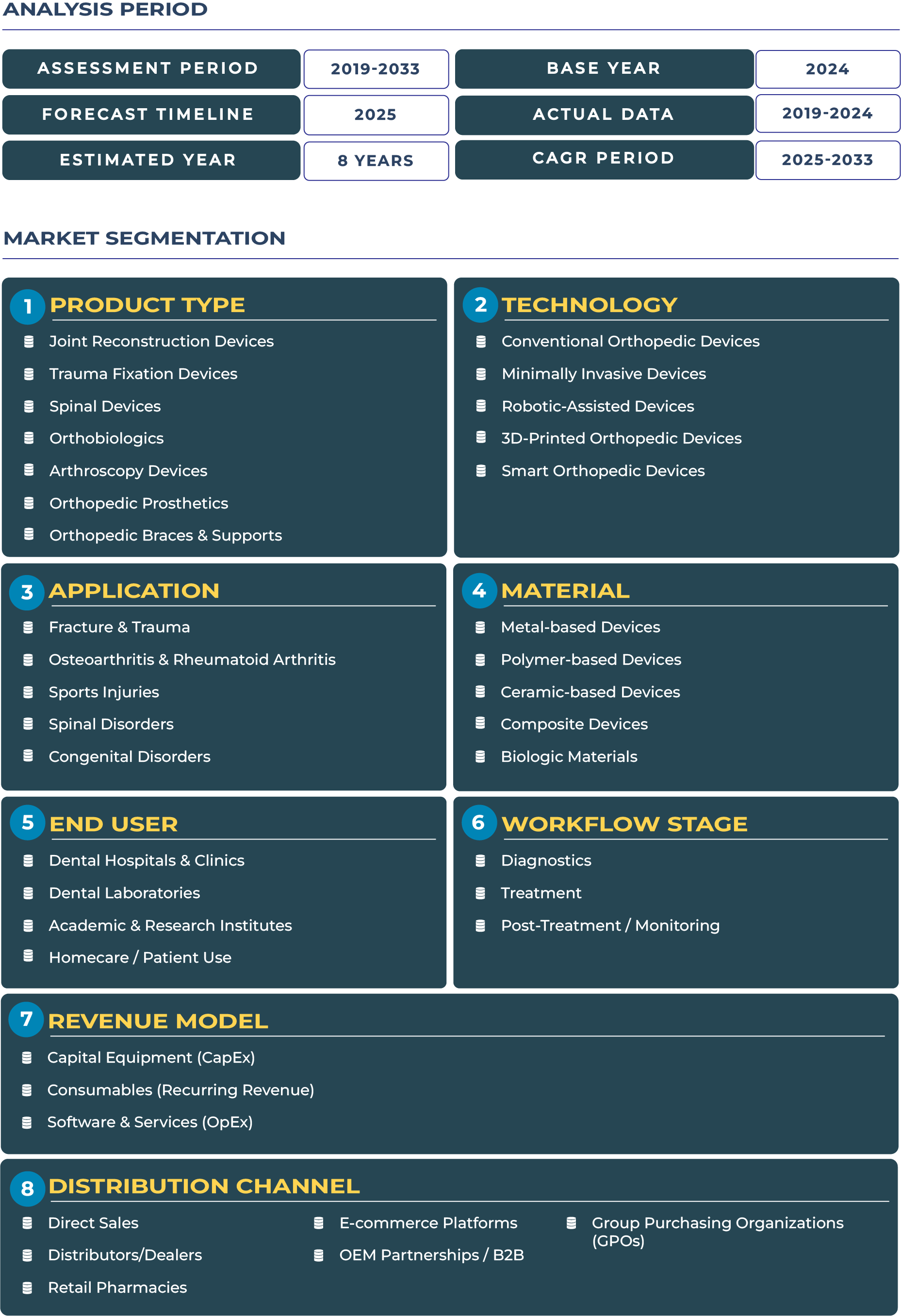Report Format:
![]()
![]() |
Pages: 110+
|
Pages: 110+
Canada’s Healthcare Framework: A Defining Catalyst for Orthopedic Devices Adoption
Canada’s publicly funded healthcare system, built on the principle of universal access, has long influenced the trajectory of medical technology adoption. In the orthopedic devices market, this framework directly impacts procurement, patient access, and cost-effectiveness, making the market distinct from countries with predominantly private systems. Orthopedic surgeries such as hip replacements, spinal stabilization, and joint reconstruction are reimbursed through provincial health insurance plans, ensuring affordability but also shaping how manufacturers and providers navigate procurement cycles. The model emphasizes cost control and equitable access, which drives adoption of durable and clinically proven orthopedic devices over experimental or cost-intensive alternatives.
Against this backdrop, the Canada orthopedic devices market is demonstrating steady expansion. Valued at USD 2.42 billion in 2025, the market is projected to reach USD 4.17 billion by 2033, growing at a CAGR of 7.0% between 2025 and 2033. Rising demand for joint reconstruction procedures, spinal stabilization surgeries, and advanced trauma fixation devices is contributing to this growth. Supportive government policies to reduce surgical backlogs and provincial investment in surgical capacity further strengthen the market outlook. At the same time, economic pressures, an aging population, and innovation in minimally invasive techniques collectively push the orthopedic devices ecosystem toward long-term stability.
Universal Healthcare, Rising Backlogs, and Shifting Patient Demands Driving the Orthopedic Devices Market in Canada
The Canadian orthopedic devices industry is poised for robust expansion due to systemic healthcare dynamics and evolving patient demographics. The universal healthcare system ensures that orthopedic procedures remain accessible, but long surgical waitlists have created pent-up demand for advanced devices and faster surgical interventions. This demand is fueling interest in arthroscopy devices and advanced spinal implants designed for outpatient or ambulatory care settings. The combination of an aging population and increasing cases of musculoskeletal disorders adds further urgency.
Government-led initiatives to shorten waitlists, along with provincial capital investments in surgical capacity, directly support adoption of innovative devices. For example, targeted funding announced across provinces in 2023–2024 focused on orthopedic surgical volumes has already shown positive outcomes, improving throughput and opening opportunities for next-generation prosthetics and trauma fixation technologies. Political stability, despite global geopolitical tensions, allows long-term procurement planning and adoption of new orthopedic technologies across provinces. Although economic pressures create stricter procurement cycles, Canada’s strong fiscal management enables sustained investments in healthcare infrastructure. Collectively, these elements establish Canada orthopedic devices sector as one of the most structured and resilient markets in North America.
Drivers & Restraints: Structural Catalysts and Procurement Hurdles Defining Growth Pathways in the Canada Orthopedic Devices Industry
Several key factors are driving growth in the Canadian orthopedic devices ecosystem. First, provincial governments have prioritized backlog clearance for orthopedic procedures, creating a surge in demand for trauma fixation devices and joint reconstruction implants. Second, the push for quality outcomes, particularly in hip and knee replacements, has driven hospitals to adopt devices that meet high clinical performance expectations, strengthening demand for trusted international and domestic brands. Third, rising provincial capital investments in surgical robotics and advanced implants are reinforcing market momentum.
However, the sector faces notable challenges. Centralized procurement systems, while ensuring equity, often delay adoption of new technologies due to lengthy tendering processes. Budget cycles tied to fiscal years slow down procurement flexibility, leading to uneven device adoption across provinces. Moreover, private sector penetration in orthopedic procedures remains lower compared to the United States, limiting opportunities for premium or experimental device segments such as robotic-assisted prosthetics or custom orthobiologics. These structural restraints temper the otherwise strong growth trajectory, requiring manufacturers to adapt with flexible financing models and long-term provincial engagement strategies.
Trends & Opportunities: Ambulatory Innovations, Regional Procurement Shifts, and Public-Private Collaborations Shaping the Canadian Orthopedic Devices Landscape
A defining trend in the Canadian orthopedic devices market is the growing role of waitlist-driven surgical surges. Provinces such as Ontario and British Columbia are implementing funding cycles that increase orthopedic surgeries during peak backlog clearance years, resulting in concentrated procurement of devices during specific periods. Ambulatory surgical pilots for knee arthroscopies and minor joint procedures are also gaining traction, as provinces explore cost-effective outpatient models to reduce hospital burden. Regional procurement hubs are consolidating tenders, creating efficiency in device adoption but also pushing manufacturers to demonstrate differentiated value across product portfolios.
Opportunities are emerging through innovative procurement and partnership models. Provincial governments are increasingly open to bundled bidding strategies, where suppliers provide comprehensive orthopedic device packages covering joint, spinal, and trauma solutions. Public-private partnerships are also expanding in ambulatory orthopedic care, where private clinics perform surgeries under provincial coverage, opening opportunities for manufacturers to place devices through hybrid channels. Additionally, leasing models for surgical robotics and prosthetics are gaining traction, allowing hospitals to manage high upfront costs while improving access to cutting-edge technologies. These opportunities underscore the need for adaptable strategies in the orthopedic devices sector to meet the evolving demands of Canada’s healthcare system.
Competitive Landscape: Strategic Alignments and Adaptive Business Models in the Canadian Orthopedic Devices Sector
The Canadian orthopedic devices industry is shaped by global leaders and regional players adapting to provincial procurement environments. International companies such as Johnson & Johnson MedTech and Zimmer Biomet remain dominant through their comprehensive portfolios in joint reconstruction and spinal devices. Local distributors and mid-sized players play a critical role in supplying trauma fixation devices and orthobiologics, aligning with provincial healthcare procurement systems.
Strategic developments are increasingly focused on early engagement with provincial procurement authorities, as proactive participation helps manufacturers secure long-term contracts and shorten tender cycles. Flexible financing and leasing models are also gaining prominence, particularly in the high-value prosthetics and robotics segments. Evidence-collection pilots, where manufacturers collaborate with hospitals to demonstrate cost-effectiveness and clinical outcomes, are strengthening adoption. For instance, provincial procurement pilots initiated in 2024 emphasized outcome-based procurement, allowing companies with strong clinical evidence to secure favorable contracts. These strategies reflect how the competitive landscape in the Canadian orthopedic devices ecosystem is evolving into a balance of innovation, affordability, and procurement alignment.







